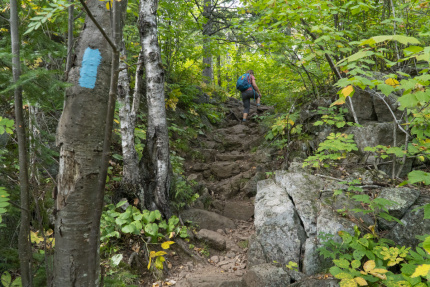Places We've Shaped
Leave No Trace On The Superior Hiking Trail

Brice
-
September 26, 2018

Duluth, Minnesota: The Superior Hiking Trail is 326 miles of diverse and rugged landscape winding from the Wisconsin/Minnesota state-line along Lake Superior clear to the border of Canada. This trail has been in the making for over 3 decades and is now enjoyed by everyone from thru hikers to dog walkers.
Here are some ways you can protect and preserve this place on your visit so the Superior Hiking Trail can continue to be enjoyed for years to come.
Conditions on the trail can change quickly and drastically, be sure you plan ahead and prepare accordingly. Check for trail conditions and current updates on the Superior Hiking Trail Association’s website. Be sure you know your route and have a plan for camping. Guidebooks, maps, and the trail information center are helpful tools for planning everything from long treks to day hikes.
Stick to the trail, this helps prevent erosion and keeps the surrounding vegetation flourishing. For those muddy days, be sure to go right through mud puddles rather than around them to avoid widening the trail.

Dogs are allowed throughout the entire trail. However for their safety and the safety of the wide variety of animals who call the trail home, they should be on a leash at all times. This includes at all campgrounds and trail-heads. Dog waste should always be picked up and packed out.
There are 94 designated campsites spread throughout the entire hiking trail, camping anywhere besides these locations is not permitted. This helps prevent water contamination, vegetation damage, and wildlife disturbance that all come with creating new campsites.
Resources such as fire-pits, latrines, and tent pads should be shared among groups.
This aids in protecting the natural space from spreading impacts and ensure that all private land areas of the trail remain open. Fires are only allowed in established fire rings in designated campsites. Remember that these are communal fires. No one group can lay claim to these amenities, use this as an opportunity to meet and interact with fellow campers.
Do not construct new fire rings or have fires anywhere else on the trail. This will lessen the chance of forest fires, spare new patches of soil and trees from being burned, and preserve the look of these pristine areas. If possible, use alternatives for cooking, light, and warmth.
Bears and other animals are attracted to food, trash, and scented items such as deodorant or sunscreen. When not stored properly, these items can be harmful to animal’s health and lead them to become aggressive. Bear canisters or hangs are required for any camping along the trail to protect animals and future campers. Bear hangs should be 12 feet from the ground and six feet from the trunk of the tree to keep food out of reach.
Catholes are recommended for disposing of human waste if you are not near a latrine. Walk 70 big steps away from the trail and any nearby water sources and dig a 6-8 inch hole. Toilet paper should be packed out if possible. If not feasible, bury it at the bottom of your cat hole and cover the area to disguise the appearance.
Whether you’re here for an afternoon walk, or hiking all 326 miles, following these tips will help protect this trail and its surrounding scenery. Enjoy the Superior Hiking Trail and Leave No Trace.
Leave No Trace's Erin Collier and Brice Esplin are part of the 2018 Subaru/Leave No Trace Traveling Trainer Program that provides free, mobile education to communities across the country. Proud partners of this program include Subaru of America, REI, Eagles Nest Outfitters, Deuter, Thule, Taxa and Klean Kanteen.
Let’s protect and enjoy our natural world together
Get the latest in Leave No Trace eNews in your inbox so you can stay informed and involved.
